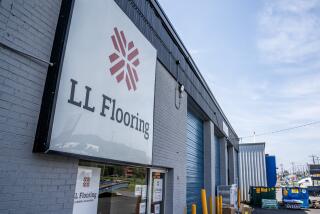SOUTHERN CALIFORNIA ENTERPRISE : Home Sewing Retailer Refashions Chain : Restructuring: House of Fabrics hopes tentative plan to close some branches and expand craft items will effect a turnaround.
These are trying times for House of Fabrics Inc.
The once-thriving Sherman Oaks-based retailer of fabrics and home sewing items has been in a slump since 1992, when earnings collapsed under the weight of the national economic recession.
Hoping to engineer a turnaround, House of Fabrics recently announced a tentative refinancing proposal, plans to close nearly a third of its existing stores, and an expanded emphasis on merchandising craft and home decorating items.
On Friday, the company announced it had appointed veteran corporate revitalization specialist David T. Allen as chief financial officer and executive vice president for administration. He succeeds Donald W. Boyer, who resigned to pursue other interests.
Allen was most recently with the national crisis management firm of Buccino & Associates Inc. Since joining Buccino in 1989, House of Fabrics said, Allen has managed more than 50 corporate turnaround and refinancing situations for large and small companies in manufacturing, retailing and distribution.
House of Fabrics faces skepticism in the financial community about its own prospects for a turnaround. “Confidence is such an important issue in remaining an ongoing concern. I just don’t know if they’re going to make it,” said Bob Simonson, a financial analyst with Kemper Securities in Chicago and one of the few analysts who still follows House of Fabrics.
The company reported an $11.6-million loss for its second quarter ended July 31 and a 15% decline in revenue, to $110 million, from the year-ago period. That’s on top of a $29.5-million loss on sales of $546 million for the year ended Jan. 31. In Nasdaq trading Friday, House of Fabrics shares closed at $2, down 12.5 cents. The stock traded as high as $41 a share in 1991, adjusted for a 2-for-1 split that year.
The company announced last month that it will close 200 of its 624 stores by Jan. 31 to cut costs.
The company’s bankers said earlier that House of Fabrics was technically in default on conditions of some loans, but it won a reprieve when the banks agreed not to declare defaults until Nov. 11. The agreement gives the firm more time to pursue financial restructuring.
House of Fabrics said last week that it had entered into an agreement with a private investment partnership that would raise much-needed capital. Under the agreement, which is subject to several conditions, Levine Leichtman Capital Partners would purchase $20 million in subordinated notes and receive warrants enabling it to buy up to 35% of House of Fabrics’ common stock at $1 a share.
House of Fabrics is also working with the Finley Group, a turnaround consulting firm based in Charlotte, N.C., and is writing a new business plan to present to its banking group.
President Gary L. Larkins declined to specify which stores will close. But the company has said it is generally targeting mall stores and some less-profitable “superstores,” primarily in the Midwest and Northeast, where House of Fabrics has strong competition. It is also liquidating inventory to lower its bank debt, which stood at $129.9 million as of Aug. 1, officials said.
House of Fabrics’ suppliers are apparently remaining steadfast. Bill Gardner, editor of the industry publication Craftrends, said he listened in on a conference call between Larkins and suppliers shortly after the company announced its plans to close stores.
Gardner said the suppliers, without prompting, expressed support for the company. Most said they would continue shipping to the retailer, even though some hadn’t been paid for as long as five months. “House of Fabrics has been honest and upfront with vendors and they appreciate it,” Gardner said. “Because of the people involved, they’re sticking with them.”
The turmoil at House of Fabrics stems from the recession as well as shifts in the apparel business and social change. With more women working outside the home, fewer people sew their own clothes, especially with the abundance of low-priced, ready-to-wear clothing that has saturated the market in recent years. The sour economy, particularly in California, where House of Fabrics has most of its outlets, plus the Jan. 17 Northridge earthquake, put further pressure on the company.
Although House of Fabrics is the weakest of the major players in the estimated $4-billion-a-year fabric retailing industry, key competitors Fabri-Centers of America of Hudson, Ohio, and Hancock Fabrics of Tupelo, Miss., have also seen their profits slip because of changing consumer habits.
The industry is also dealing with a massive hangover from overexpansion in the 1980s. Today, there are too many stores vying for the business of too few home sewing customers.
If it gets its financial house in order, House of Fabrics will look to its new crafts and home decorating emphasis for salvation. Last year, the company hired Doyle W. Parker, a former Wal-Mart Inc. craft buyer, to head its craft buying. It launched four prototype stores--dubbed “Creative Centers”--at former Southern California fabric superstores in Valencia, Simi Valley, Torrance and Temecula. The company will convert four more of its stores--which carry a trimmed-down line of fabrics--in the next 60 days, Larkins said. If all goes well, it hopes to have another 20 such outlets in the near future.
House of Fabrics has sold crafts at its outlets since the early 1980s, but company officials believe such merchandise can make up a greater portion of total sales because of the public’s rising interest in crafts and home decorating. In the fiscal year ended Jan. 31, crafts represented about 15% of company sales, but Larkins said he believes that share can rise to between 20% and 25%.
The House of Fabrics prototype store in Simi Valley is a 24,000-square-foot showroom featuring a huge selection of craft items, such as baskets, artificial flowers, pillows, needle craft, dolls and figurines, plus fabric for home sewing and decorating.
Before the earthquake, the location was a House of Fabrics superstore. It was damaged by the temblor and reopened five months later as one of the new concept stores.
Christie McAdams, manager of the Simi Valley store, said sales have been climbing there ever since--up 62% in June, 50% in July and 21% in August. “We’re getting more and more crafts customers,” she said.
The Hobby Industry Assn. in Elmwood Park, N.J., estimates total 1993 retail sales for the crafts industry at $9.6 billion. For the past four years, despite the recession, the industry has registered healthy annual gains.
More to Read
Inside the business of entertainment
The Wide Shot brings you news, analysis and insights on everything from streaming wars to production — and what it all means for the future.
You may occasionally receive promotional content from the Los Angeles Times.










